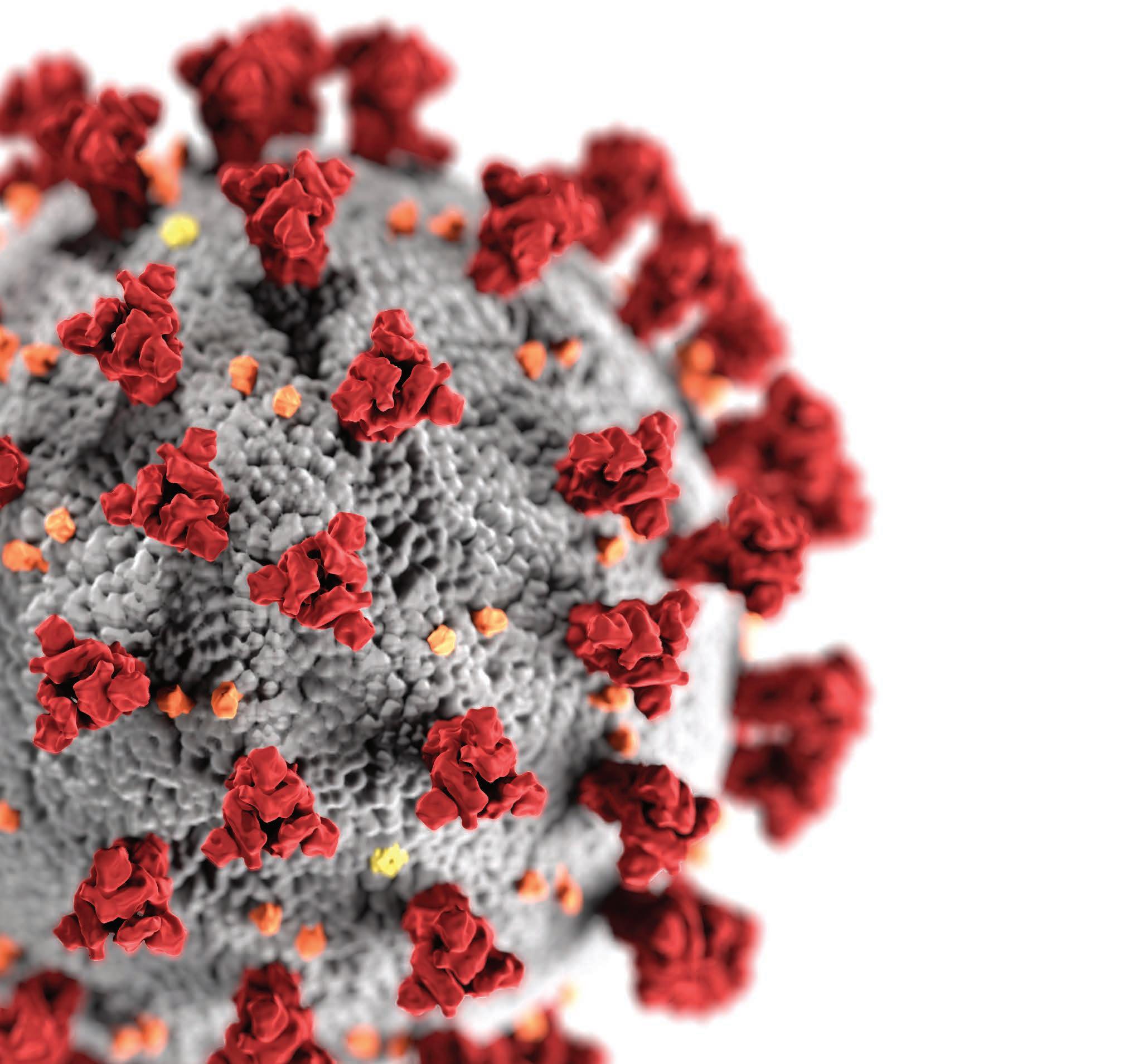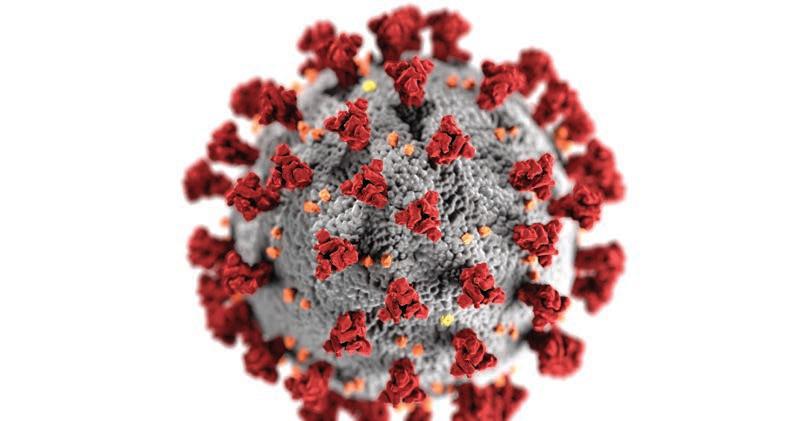
5 minute read
VACCINE UPDATE
from a VIROLOGIST PERSPECTIVE
Andrew Yurochko, PhD
Advertisement
Professor and Carroll Feist Endowed Chair of Viral Oncology and Department Vice-Chair of Microbiology and Immunology

Coronaviruses are a family of large RNA viruses that infect mammals and birds and cause respiratory infections and disease. There are 7 known human coronaviruses that originally appear to have come from animals. Of these 7 human coronaviruses, 4 are largely benign and cause approximately 25-30% of the cases of the common cold. The remaining 3 human coronaviruses are more deadly and include SARS-CoV (Severe Acute Respiratory Syndrome-Coronavirus; caused the SARS outbreak in 20022004), MERS-CoV (Middle East Respiratory Syndrome-related Coronavirus, an ongoing infection largely limited to the Middle East), and SARS-CoV-2 (Severe Acute Respiratory SyndromeCoronavirus-2, the current pandemic virus that causes COVID-19 or Coronavirus Disease–2019). The current coronavirus pandemic has as of the beginning of December resulted in approximately 14 million infections and approximately 275,000 deaths in the U.S. alone. With cases spiking in the U.S. and Europe and winter approaching it has been suggested that much of the world is in for a rough winter.
Based on these warnings, most people are wondering “how do we get out of this pandemic and return to a normal life”. The end goal that has received significant attention is the development and wide spread distribution of an effective vaccine. Vaccines allow society to safely reach herd immunity that would otherwise be difficult under natural conditions. To date, no “dangerous pathogen” has via natural infection resulted in herd immunity. For example, the eradication of smallpox in 1976 was only possible with concerted worldwide vaccination efforts. The same idea holds true for the current polio eradication efforts, where through the use of an effective vaccine, the world health organization has limited endemic wild type polio to only two countries as of November 2020.
Currently there are more than 150 SARS-CoV-2 vaccines in clinical trials around the world, with nearly 10 in phase III trials. In the U.S., there are at least 4 vaccines in phase III trials with results on the efficacy of these trials being announced daily. The 4 main vaccines in phase III trials in the U.S. are vaccines from Moderna, Pfizer/BioNTech, Oxford/AstraZeneca, and Johnson & Johnson. These different vaccines represent distinct approaches, with the Moderna and Pfizer/BioNTech vaccines being mRNA-based vaccines and the Oxford/AstraZeneca and Johnson & Johnson vaccines being adenoviral-vector-based vaccines. mRNA-based vaccines have been around for more than 20 years, but have come into their own in the last decade. mRNA vaccines represent a new tool in the vaccine arsenal as they can be created quickly (once a viral genomic sequence is known, for example) and tested quickly. mRNA-based vaccines rely on the power of the vaccinated host to translate the mRNA into a protein of interest. For Moderna and Pfizer, their vaccines are focused on the spike protein. All coronaviruses have a spike protein because this is the protein responsible for viral attachment to the infected cell. Nevertheless, there are regions on a coronavirus’ spike protein that are unique to each virus that can be specifically targeted by the immune response to control infection with that virus. mRNA based vaccines are very amenable to rapid production and can be quickly constructed, however, once marketed, to remain stable they must be stored frozen (at least that is a current limitation). This vaccine route requires two separate shots a few weeks apart. The University of Oxford collaboration with AstraZeneca has taken a different approach and is using a non-replicating chimpanzee adenoviral vector that they have experience using in other studies. The vector expresses the SARS-CoV-2 spike protein and thus acts as an immunogen. In initial trials a second dose increased immunity. Johnson & Johnson is using an adenoviral vector that expresses the spike protein that they hope only requires a single shot. They are using a modified human adenoviral vector that they utilized during their creation of an Ebola vaccine. Novavax is another company that should start phase III trials in the U.S. soon. Other approaches, such as the use of inactivated whole virus are also being used in other vaccine candidates.
It is expected that these vaccines will stimulate a robust humoral and cell-mediated immune response that would provide protection from disease caused by SAR-CoV-2 infection and possibly mitigate some level of infection. Because all available data suggests that infected humans generate an immune response to a coronavirus infection, there is no inherent reason why a vaccine should not provide protection. Arguments have been made as to what type of immunity may be generated. In general, these types of vaccines generate an IgG antibody response and thus should protect the lower respiratory tract. Because IgA is often required to protect the upper respiratory tract, it remains unclear if the vaccines will prevent disease through disruption of infection of the lower respiratory tract or if they will mitigate and/or block infection in general. To exit the current pandemic this is likely an unimportant fact but could play a role in the length of time of the pandemic if a large percentage of folks do not get vaccinated. Also not discussed in most press releases is the ability to generate cell-mediated or T cell immunity. T cell-mediated immunity does develop in coronavirus-infected individuals and plays a vital role in host defense. Most studies seem to focus on the antibody response and then the waning of the antibody response. These are all normal processes and because an effective immune response to most pathogens generates immunological memory that lasts from months, to years and even for a lifetime for many pathogens, these vaccines should be able to provide efficacious and strong protection for the vaccinated host.
Through the use of modern techniques and accelerated trials, we are seeing safe and effective SARS-CoV-2 vaccine being brought to market in record time. The previous fastest vaccine to market was about 4 years and many vaccines take 10-15 years to develop, test, and bring to market. Certainly, the current pandemic has spurred rapid action to quickly develop a vaccine. At present the safety profiles look good and there is no evidence that any safety corners are being cut. Currently it appears that several of the current phase III vaccines and/or current phase I/phase II vaccines will come to market allowing large scale vaccination and a return to our new normal lives.
Lessons learned from the current pandemic are critically important for future vaccine development and will pay a key role in how effectively our world responds to pathogens of the future.










